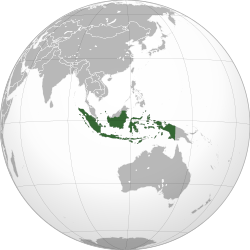Indonesia
3:22 AMIndonesia
From Wikipedia, the free encyclopedia
Indonesia ( i/ˌɪndəˈniːʒə/ in-də-nee-zhə or /ˌɪndoʊˈniːziə/ in-doh-nee-zee-ə; Indonesian: [ɪndonesia]), officially the Republic of Indonesia (Indonesian: Republik Indonesia [rɛpublik ɪndonesia]), is a sovereign transcontinental country located mainly inSoutheast Asia with some territories in Oceania. Situated between the Indian and Pacific oceans, it is the world's largest island country, with more than thirteen thousand islands.[9][10] It has an estimated population of over 260 million people (September 2016) and is the world's fourth most populous country, most populous Austronesian nation, as well as the most populous Muslim-majority country. The world's most populous island of Java contains more than half of the country's population.
i/ˌɪndəˈniːʒə/ in-də-nee-zhə or /ˌɪndoʊˈniːziə/ in-doh-nee-zee-ə; Indonesian: [ɪndonesia]), officially the Republic of Indonesia (Indonesian: Republik Indonesia [rɛpublik ɪndonesia]), is a sovereign transcontinental country located mainly inSoutheast Asia with some territories in Oceania. Situated between the Indian and Pacific oceans, it is the world's largest island country, with more than thirteen thousand islands.[9][10] It has an estimated population of over 260 million people (September 2016) and is the world's fourth most populous country, most populous Austronesian nation, as well as the most populous Muslim-majority country. The world's most populous island of Java contains more than half of the country's population.
Indonesia's republican form of government includes an elected legislature and president. Indonesia has 34 provinces, of which five have Special Administrative status. Its capital and most populous city is Jakarta. The country shares land borders with Papua New Guinea, East Timor, and the eastern part of Malaysia. Other neighbouring countries include Singapore, the Philippines, Australia, Palau, and the Indian territory of the Andaman and Nicobar Islands. Indonesia is a founding member of ASEAN and a member of the G-20 major economies. The Indonesian economy is the world's 16th largest by nominal GDP and the 8th largest by GDP at PPP.
The Indonesian archipelago has been an important region for trade since at least the 7th century, when Srivijaya and then later Majapahit traded with China and India. Local rulers gradually absorbed foreign cultural, religious and political models from the early centuries CE, and Hindu and Buddhist kingdoms flourished. Indonesian history has been influenced by foreign powers drawn to its natural resources. Muslim traders and Sufi scholars brought the now-dominant Islam,[11][12] while European powers brought Christianity and fought one another to monopolise trade in the Spice Islands of Maluku during the Age of Discovery. Following three and a half centuries of Dutch colonialism starting from Amboina and Batavia, and eventually all of the archipelagoincluding Timor and West Papua, at times interrupted by Portuguese, French and British rule, Indonesia secured its independence after World War II. Indonesia's history has since been turbulent, with challenges posed by natural disasters, mass slaughter,corruption, separatism, a democratisation process, and periods of rapid economic change.
Indonesia consists of hundreds of distinct native ethnic and linguistic groups. The largest – and politically dominant – ethnic group are the Javanese. A shared identity has developed, defined by a national language, ethnic diversity, religious pluralism within a Muslim-majority population, and a history of colonialism and rebellion against it. Indonesia's national motto, "Bhinneka Tunggal Ika" ("Unity in Diversity" literally, "many, yet one"), articulates the diversity that shapes the country. Despite its large population and densely populated regions, Indonesia has vast areas of wilderness that support the world's second highest level of biodiversity. The country has abundant natural resources like oil and natural gas, tin, copper and gold. Agriculture mainly produces rice,tea, coffee, spices and rubber. Indonesia's major trading partners are Japan, the United States and the surrounding countries of Singapore, Malaysia and Australia.










0 comments